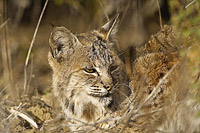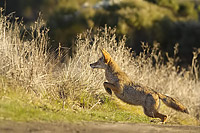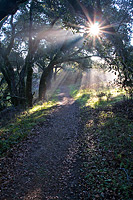Home -> Articles -> Nature Photography and Trail Running
~ Nature Photography and Trail Running*~
Running with camera gear - written by Greg Cope
In the early morning light as the sun rose to my back, my heart would be pounding and my breath fast as I ran along a trail near my home. Turning the corner of the trail I saw a bobcat in an adjacent meadow. A little early morning exercise was plenty to wake me up, but coming across a rare scene like that was better than drinking the strongest coffee imaginable. Heart pounding and breathing hard, I'd frequently watch wildlife appear unannounced on my morning trail runs. An exciting and unexpected experience, it was disappointing that I did not have my camera in hand so I could share these experiences with others. And it wasn't always just the wildlife. Running to distant locations to watch and photograph the sunset or sunrise was just as exciting. Alternatively, the many times I headed out with my camera to photograph these locations, I would inevitably come home with an empty memory card in my camera. The difference frustrated me, and out of this frustration emerged a thought: why not trail run with my camera?
 Well I could think of a few reasons. Falling with an expensive camera in hand wasn't a pleasant thought. Neither was the thought of running with the extra pounds of camera gear. But one day, I pushed reason aside and decided to try trail running with my camera. Gathering the biggest padded fleeces I could find I wrapped my camera, wide angle and telephoto lenses, and tripod tightly up and into a backpack, slung it all on my back and in the pre-dawn hours began the hefty run into Windy Hill Open Space Preserve. As the sun rose above the horizon, I rounded the bend of a hill and off to my right rested a bobcat. I spent almost an hour alone with this bobcat as we watched the sun rise together. Being the closest I have ever been to one of these beautiful and wild animals, I also had one of the best photographic opportunities I have had to date. I became hooked on running with camera from then on, having experience after experience.
Well I could think of a few reasons. Falling with an expensive camera in hand wasn't a pleasant thought. Neither was the thought of running with the extra pounds of camera gear. But one day, I pushed reason aside and decided to try trail running with my camera. Gathering the biggest padded fleeces I could find I wrapped my camera, wide angle and telephoto lenses, and tripod tightly up and into a backpack, slung it all on my back and in the pre-dawn hours began the hefty run into Windy Hill Open Space Preserve. As the sun rose above the horizon, I rounded the bend of a hill and off to my right rested a bobcat. I spent almost an hour alone with this bobcat as we watched the sun rise together. Being the closest I have ever been to one of these beautiful and wild animals, I also had one of the best photographic opportunities I have had to date. I became hooked on running with camera from then on, having experience after experience.
 While I don't condone trail running while carrying several thousand dollars of camera gear, I have found some of the best wildlife experiences and some incredible nature photography while trail running - being able to run far into the depths of the wilderness in the early morning or late evening away from people and towards the wildlife. Running allowed me to penetrate the wilderness faster than hiking, and reach locations where the wildlife population quickly exceeds the human population. And for an exercise addict like me, trail running was a perfect way to get my running fix, nature fix, and at the same time always have the anticipation of finding a unique photo opportunity.
While I don't condone trail running while carrying several thousand dollars of camera gear, I have found some of the best wildlife experiences and some incredible nature photography while trail running - being able to run far into the depths of the wilderness in the early morning or late evening away from people and towards the wildlife. Running allowed me to penetrate the wilderness faster than hiking, and reach locations where the wildlife population quickly exceeds the human population. And for an exercise addict like me, trail running was a perfect way to get my running fix, nature fix, and at the same time always have the anticipation of finding a unique photo opportunity.
 There is not much required to combine nature photography and trail running. Of course, I would recommend you are in shape and able to run on uneven ground for extended periods of time. Plan your runs early or late in the day, using the morning and evening light to your advantage. Try to run with a partner (if possible) and choose trails with more dirt than rocks; trails that do not require much maneuvering around rocks and tree roots; and on familiar trails. Run safely at a moderate to slow pace - even combining running and hiking - paying special attention to foot placement to avoid tripping. In addition, walking rather than running downhill helps keep your pace under control and is more gentle on the knees. Always be prepared to trip and at the least fall head over heals...which means do not run with camera in hand, having it tucked away in a well padded location (while I have yet to have a nasty fall - knock on wood - I have come quite close too many times to count). In addition to camera gear, carry first aid and emergency items, such as a cell phone, first aid kit, and whistle. My backpack is small enough to be comfortable carrying a large telephoto lens and other equipment but has little padding, and I usually use at least 2 or 3 high volume fleece sweatshirts to fill my pack and pad my camera gear. Although backpacks specifically designed to carry camera gear come with a good deal of padding, I would still recommend padding your gear well and tight into its cradle; a backpack with a hip belt and chest strap decreases the bouncing and jostling of equipment as you jog down the trail. Opt for lighter camera gear, even bringing a single lens or - lighter still - simply a point and shoot camera. Finally read, understand, and accept the disclaimer at the end of this article.
There is not much required to combine nature photography and trail running. Of course, I would recommend you are in shape and able to run on uneven ground for extended periods of time. Plan your runs early or late in the day, using the morning and evening light to your advantage. Try to run with a partner (if possible) and choose trails with more dirt than rocks; trails that do not require much maneuvering around rocks and tree roots; and on familiar trails. Run safely at a moderate to slow pace - even combining running and hiking - paying special attention to foot placement to avoid tripping. In addition, walking rather than running downhill helps keep your pace under control and is more gentle on the knees. Always be prepared to trip and at the least fall head over heals...which means do not run with camera in hand, having it tucked away in a well padded location (while I have yet to have a nasty fall - knock on wood - I have come quite close too many times to count). In addition to camera gear, carry first aid and emergency items, such as a cell phone, first aid kit, and whistle. My backpack is small enough to be comfortable carrying a large telephoto lens and other equipment but has little padding, and I usually use at least 2 or 3 high volume fleece sweatshirts to fill my pack and pad my camera gear. Although backpacks specifically designed to carry camera gear come with a good deal of padding, I would still recommend padding your gear well and tight into its cradle; a backpack with a hip belt and chest strap decreases the bouncing and jostling of equipment as you jog down the trail. Opt for lighter camera gear, even bringing a single lens or - lighter still - simply a point and shoot camera. Finally read, understand, and accept the disclaimer at the end of this article.
Trail running is not for everyone. But should you enjoy running and photography, consider giving it a try sometime, taking extreme care and always keeping an eye out for the next photographic opportunity. Who knows what will emerge around the next bend....
*Disclaimer: Trail running is a dangerous sport. Trail running with weight on your back in the form of expensive camera gear is even more dangerous. Use extra caution and be safe during these activities. Should you decide to partake in the activities described in this article, you accept all risk and responsibility associated with these activities. You the runner fully understand the risk of injury to yourself and damage to your camera gear - you are responsible for yourself, your camera gear, and personal safety. Greg Cope and www.naturefocused.com accept no liability for injury or damage caused by trail running with your camera gear.